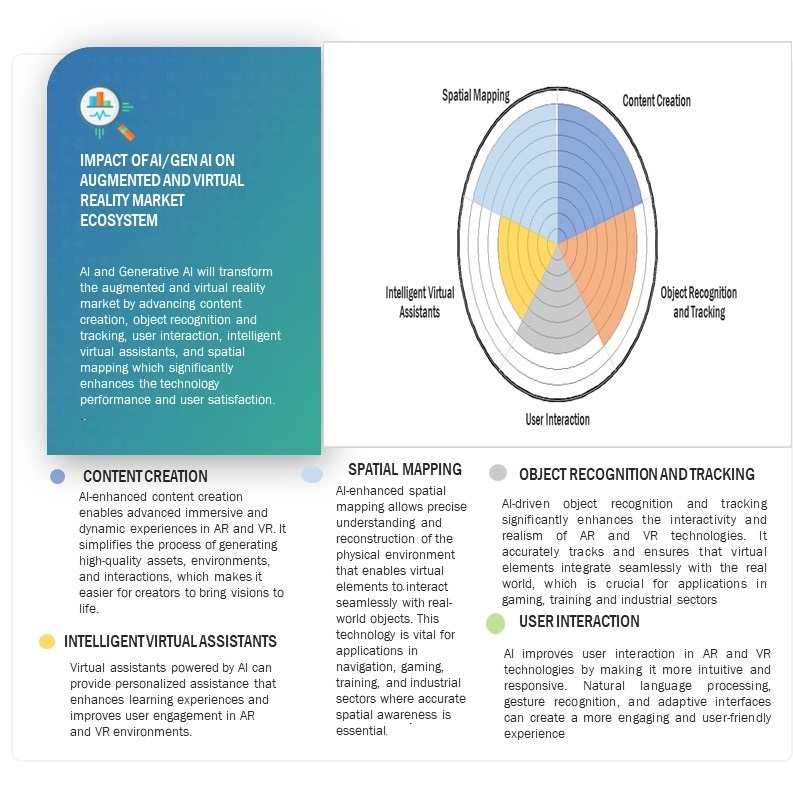The major use cases of AI/Gen AI in the augmented and virtual reality market includes content creation, object recognition and tracking, user interaction, intelligent virtual assistants and spatial mapping. AI-enhanced content creation empowers the fast and easy generation of quality assets, environments, and interactions that provide more immersive and dynamic AR and VR experiences.
AI-driven object recognition and tracking boost interactivity and realism several-fold by ensuring that virtual elements fit well into the real world—key to gaming, training, and industrial applications. Besides, AI enhances user interaction with intuitive and responsive interaction through natural language processing, gesture recognition, and adaptive interfaces that give better user engagement. Other benefits are AI-powered virtual assistants that can provide personalized aid and learn; however, their full potential is again limited because of technological and integrational challenges. Finally, spatial mapping enhanced by AI is required in the development of most immersive AR and VR experiences, since it accurately perceives and reconstructs physical environments; in this regard, spatial awareness drives applications like navigation, gaming, and training.
The Augmented Reality and Virtual Reality Market was valued at USD 22.12 billion in 2024 and is expected to reach USD $96.32 billion by 2029, at a CAGR of 34.2% during the 2024-2029 period.
Download PDF Brochure:
https://www.marketsandmarkets.com/pdfdownloadNew.asp?id=1185
Rapid growth of AR and VR applications in the gaming and entertainment industry are the major drivers of the augmented and virtual reality market. This is attributed to AR delivering uncommon combination that refashions how people relate with the digital content and VR enhancing the performance, compactness, and comfort such as Apple Vision Pro, Meta Quest 3. Furthermore, the growing implementation of government initiatives and investments towards AR and VR technologies provides growth opportunities in the augmented and virtual reality market.
Rapid growth of AR and VR applications in the gaming and entertainment industry
Demand for AR has been ever-increasing within the gaming and entertainment market simply because of its ability to alter a user’s experience in extraordinary ways. AR puts together the uncommon combination of immersion and interactivity that refashions how people relate with digital content. On the gaming front, AR is creating worlds that merge the real and the virtual, urging players to explore their surroundings and collaborate with others in becoming part of the game. It physicalizes gameplay and encourages an active physical lifestyle and fosters the solving of problems.
Presence of privacy infringement and technological constraints
The rapid evolution of AR technology has launched a wave of creative applications and experiences. These result in enhanced interactions between the digital and physical worlds in exciting ways, which give rise to critical concerns about potential security and privacy issues. AR technology often lays digital information over the top real world, mingling new routes of data collection and sharing. As digital elements become gradually aware of, and augment physical environments, there is an increased likelihood of collecting personal data such as location information, images, as well as behavioral patterns. This information is applied in creating elaborate profiles for each person, hence raising concerns about its gathering, retention, and exploitation, thereby limiting the expansion of the AR technology market being bounded.
Growing implementation of government initiatives and investments
Governments across the world are inducing the development of the AR market with their support in terms of AR funding, R&D support, startup grants, and partnership with academic institutes. For instance, In September 2023, a UK-based holographic company Envisics, that manufactures in-car technology that projects navigation, safety alerts onto the windscreen rose USD 100 million in its Series C round is projected to commercialize AR head-up displays during the forecast period. Furthermore, in August 2023, companies like Snapchat launched the reward lens creator program with AR creators and developers in order to monetize their top-performing lenses. If an AR lens creator’s invention achieves high engagement in countries such as the United States, India, or Mexico, they could potentially earn up to USD 7,200 per month. Such developments fuels the awareness of AR market which thereby drives the market growth of AR in the future.
Lack of flexibility and technical issues in various AR VR products
The lack of flexibility within the different AR platforms rises deep concern over the development of such AR technology. Compatibility issues arise as the key problem because most AR platforms often have their proprietary hardware and software; hence, they make it hard to create content for an all-in-one system with interchangeable parts. In addition, development of cross-platform AR applications is complicated and time-consuming; again, it often necessitates that several versions are made or that specialized tools be used, which will multiply development costs and delay time-to-market, which will in turn hinder the growth of the AR technology market.

